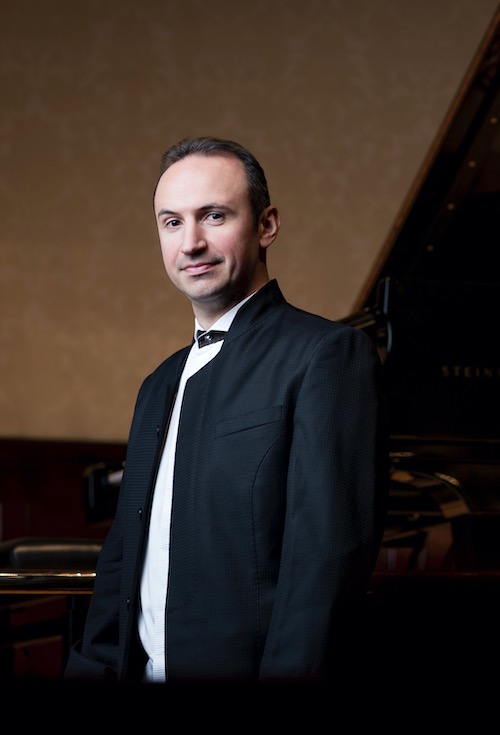Trpčeski lights a fire with blazing bravura for Friends of Chamber Music

Pianist Simon Trpčeski performed a recital Tuesday night at FIU’s Wertheim Performing Arts Center. Photo: B Ealovega
There are pianists who are technically adept and accomplished. Then there are pianists whose technique seems to transcend what is possible on the instrument.
Count Simon Trpčeski among the latter group. The Macedonian pianist made an overdue return to South Florida on Tuesday night with a stunning recital for Friends of Chamber Music at Florida International University’s Wertheim Performing Arts Center.
His performance was not without disruptions. During Brahms’ Variations on a Theme of Robert Schumann, the first work on the program, a cell phone went off, causing Trpčeki to pause. Later an audience member yelled out about a slight hum from the hall’s lighting or air conditioning system, thinking that it may have been the pianist’s hearing aid. Still, Trpčeski managed to triumph over those distractions in a sheer display of agility and artistry.
Unlike Brahms’ Haydn, Handel and Paganini variations, the Schumann set is rarely played. More restrained and less overtly virtuosic than those works, the Schumann variations are still a minefield for the keyboardist who dares attempt them. After straightforwardly stating the thematic motif from Schumann’s Albumblätter (Album-leaves), Trpčeski charged ahead into the fast variations. The fistfuls of keyboarding spanning notes were accomplished with total accuracy. Through the course of Brahms’ score, he exhibited a sensitive touch as well as fierceness of attack. Trpčeki’s dynamics ran the full gamut from thunderous to the softest pianissimos.
In many ways, Edvard Grieg’s original 1884 solo piano version of the Holberg Suite was the evening’s true gem. Usually heard in the composer’s later arrangement for string orchestra, the piano iteration at times sounds like a different work. The ornamentation and bravura writing are refreshing to jaded ears used to the more staid string transcription.
Trpčeski tossed off the opening “Praeludium” with brio, and the “Gavotte” emerged invigorated with runs absolutely precise. A Baroque sensibility permeated the “Air,” the heart of Trpčeski’s reading. His pearly touch, nuanced phrasing and musical intelligence brought a level of depth and gravitas rarely lavished on this music. A sparkling, brilliantly played “Rigaudon” brought the audience to its feet. It was a pleasure to experience Grieg’s work in a whole new light.
The music of Prokofiev, early and mature, was the main focus of the program’s second half with a Beethoven interlude. Tales of an Old Grandmother, Op. 31 is a four-movement, folk-based suite. The quirky opening Moderato and rumbling balletic melody of the Andante assai are unmistakably imbued with Prokofiev’s signature. Most striking is the final Sostenuto in which the repeated Dies irae motif suggests the aging woman’s time is ending. Trpčeski made these miniatures sing and throb.
While Beethoven is revered for his titanic, revolutionary musical statements, his music could also be playful and charming. The Contradances and Creatures of Prometheus ballet score are examples of his more lighthearted side. The 12 Variations on the Russian Dance from “Das Waldmädchen” are delightful, infused with song filled but also a test of pianistic skill. The evenness and balance of Trpčeski’s traversal were a model of instrumental command. Every note was finely etched in his fleet fingered demonstration of dynamic musicality.
Prokofiev’s wartime Piano Sonata No. 7 in B-flat minor, Op. 83 was premiered in 1943 by Sviatoslav Richter and introduced to America by Vladimir Horowitz. It is not an exaggeration to say that Trpčeski’s volcanic performance of this daunting creation matched those two legends. This is not a score for the faint of heart nor those lacking in technical fluency.
Extremes of speed and volume marked the first movement Allegro inquieto. In the Andante caloroso, Prokofiev’s seemingly lyrical theme was molded with solemnity, the dark undertones potently emphasized. In the tumultuous climaxes, the vibrations from Trpčeski’s high voltage accentuations could be felt as well as heard in the hall. He may have set a record for fast tempos in the concluding Precipitado but there was no fudging or smearing of lines. Every voice was clear, precisely scaled and transparent.
Trpčeski captured the score’s savage brutality and violence. In the coda, his hands were a blur as they traversed across the entire keyboard at breakneck pace. The standing ovation and bravos that followed were richly deserved.
Trpčeski acknowledged the enthusiastic audience response with three encores. There were more keyboard highjinks in Prokofiev’s Humorous Scherzo and Rodion Shchedrin’s Humoresque. The Moderato e grazioso (third movement) from Beethoven’s Sonata in E-flat Major, Op. 31, no.3 presented another side of this steel-fingered artist. Nobly phrased and spaciously paced, this was gentle, song-filled Beethoven.
Happily, this remarkable pianist will be returning next season.
Friends of Chamber Music presents the Tetzlaff Quartet playing Haydn’s Quartet in F minor, Op. 20, no. 5, Alban Berg’s String Quartet and Schubert’s Quartet No. 14 (“Death and the Maiden”) 8 p.m. April 26 at Temple Beth Am in Pinecrest. miamichambermusic.org
The 2022-2023 season of the Friends of Chamber Music will feature the Schumann Quartet, pianists Vadym Kholodenko, Stephen Hough and Simon Trpčeski, the David Shifrin Trio, New York Philharmonic Quartet, Hermitage Trio, Ehnes Quartet, Diaz String Trio and cellist William DeRosa with pianist Ken Noda.
Posted in Performances
Leave a Comment
Wed Apr 13, 2022
at 11:57 am
No Comments